QUESTIONS PowerPoint PPT Presentation
1 / 24
Title: QUESTIONS
1
QUESTIONS
- Atmospheric CO2 has a lifetime (turnover time) of
5 years against photosynthesis and a lifetime of
10 years against dissolution in the oceans. What
is its overall atmospheric lifetime? - 2. Are the following loss processes first-order
(linear with concentration? A. Uptake of CO2
by the biosphere B. Photolysis of gases in the
stratosphere - C. Scavenging of aerosol particles by
precipitation - 3. Consider a 2-box model for the atmosphere
where one box is the troposphere (1000-150 hPa)
and the other the stratosphere - (150-1 hPa). The lifetime of air in the
stratosphere is 2 years. What is the lifetime of
air in the troposphere? - 4 . Of the simple models we discussed in chapter
3, which one would be best suited for addressing
the following problems? - a. Is the observed rise of atmospheric CO2
concentrations consistent with the known rate of
CO2 emission from fossil fuel combustion? - b. Large amounts of radioactive particles are
released to the atmosphere in a nuclear power
plant accident. Which areas will be affected by
this radioactive plume? - c. An air pollution monitoring station in Fort
Collins suddenly detects high concentrations of a
toxic gas. Where is this gas coming from?
2
CHAPTER 6 GEOCHEMICAL CYCLES
THE EARTH ASSEMBLAGE OF ATOMS OF THE 92 NATURAL
ELEMENTS
- Most abundant elements oxygen (in solid earth!),
iron (core), silicon (mantle), hydrogen (oceans),
nitrogen, carbon, sulfur - The elemental composition of the Earth has
remained essentially unchanged over its 4.5 Gyr
history - Extraterrestrial inputs (e.g., from meteorites,
cometary material) have been relatively
unimportant - Escape to space has been restricted by gravity
- Biogeochemical cycling of these elements between
the different reservoirs of the Earth system
determines the composition of the Earths
atmosphere and oceans, and the evolution of life
3
BIOGEOCHEMICAL CYCLING OF ELEMENTSexamples of
major processes
Physical exchange, redox chemistry, biochemistry
are involved
Surface reservoirs
4
HISTORY OF EARTHS ATMOSPHERE
N2 CO2 H2O
O2
O2 reaches current levels life invades continents
oceans form
CO2 dissolves
Life forms in oceans
Onset of photosynthesis
Outgassing
4.5 Gy B.P
4 Gy B.P.
0.4 Gy B.P.
3.5 Gy B.P.
present
5
COMPARING THE ATMOSPHERES OF EARTH, VENUS, AND
MARS
6
EVOLUTION OF O2 AND O3 IN EARTHS ATMOSPHERE
7
Atmospheric Composition (average)1 ppm
1x10-6red increased by human activity
Ozone has increased in the troposphere, but
decreased in the stratosphere.
8
NOAA Greenhouse Gas records
Montreal Protocol- 1996
9
OXIDATION STATES OF NITROGENN has 5 electrons in
valence shell a9 oxidation states from 3 to 5
Increasing oxidation number (oxidation reactions)
free radical
free radical
Decreasing oxidation number (reduction reactions)
10
THE NITROGEN CYCLE MAJOR PROCESSES
combustion lightning
free radical
ATMOSPHERE
N2
NO
oxidation
HNO3
denitri- fication
biofixation
deposition
orgN
decay
NH3/NH4
NO3-
BIOSPHERE
assimilation
nitrification
weathering
burial
LITHOSPHERE
"fixed" or "odd" N is less stable globally than N2
11
BOX MODEL OF THE NITROGEN CYCLE
Inventories in Tg N Flows in Tg N yr-1
12
N2O LOW-YIELD PRODUCT OF BACTERIAL NITRIFICATION
AND DENITRIFICATION
- Important as
- source of NOx radicals in stratosphere
- greenhouse gas
IPCC 2007
13
PRESENT-DAY GLOBAL BUDGET OF ATMOSPHERIC N2O
IPCC 2001
Although a closed budget can be constructed,
uncertainties in sources are large! (N2O atm
mass 5.13 1018 kg x 3.1 10-7 x28/29 1535 Tg )
14
BOX MODEL OF THE N2O CYCLE
15
(No Transcript)
16
SULFUR CYCLE
Most sulfur is tied up in sediments and soils.
There are large fluxes to the atmosphere, but
with short atmospheric lifetimes, the atmospheric
S burden is small. SO2 Anthropogenic (fossil
fuel combustion) source comparable to natural
sources (soils, sediments, volcanoes) Sulfur is
oxidized in the atmosphere SO2 ---- gt
H2SO4 S(IV) S(VI) Sulfate is an
important contributor to acidity of
precipitation. Sulfuric acid has a low Pvap and
thus partitions primarily to aerosol/aqueous
phase Strongly perturbed by human activities!
17
FAST OXYGEN CYCLE ATMOSPHERE-BIOSPHERE
- Source of O2 photosynthesis
- nCO2 nH2O g (CH2O)n nO2
- Sink respiration/decay
- (CH2O)n nO2 g nCO2 nH2O
CO2
O2 lifetime 5000 years
Photosynthesis less respiration
O2
orgC
orgC
decay
litter
18
however, abundance of organic carbon in
biosphere/soil/ocean reservoirs is too small to
control atmospheric O2 levels
19
SLOW OXYGEN CYCLE ATMOSPHERE-LITHOSPHERE
O2 lifetime 3 million years
O2 1.2x106 Pg O
CO2
O2
Photosynthesis decay
runoff
Fe2O3 H2SO4
weathering
CO2
O2
orgC
FeS2
OCEAN
CONTINENT
orgC
Uplift
burial
CO2
orgC 1x107 Pg C FeS2 5x106 Pg S
microbes
FeS2
orgC
SEDIMENTS
Compression subduction
20
ATMOSPHERIC CARBON
Unreactive Carbon CO2 GHG (more to follow)
(tATM20 yrs) Reactive Carbon CH4 GHG,
important in oxidant chemistry (tATM9
yrs) CO important in oxidant chemistry
(later) (tATM2 mos) NMHCs source of CO,
oxidant chemistry (tATMsec-mos) Black Carbon
radiatively important (tATMdays)
CH4 (C -IV)
CO (C II)
CO2 (C IV)
Oxidation
21
SOURCES OF ATMOSPHERIC METHANE
BIOMASS BURNING 20
ANIMALS 90
WETLANDS 180
LANDFILLS 50
GLOBAL METHANE SOURCES (Tg CH4 yr-1)
GAS 60
TERMITES 25
COAL 40
RICE 85
22
SINKS OF ATMOSPHERIC METHANE
- Transport to the Stratosphere
- Only a few percent, rapidly destroyed ? BUT the
most important source of water vapour in the dry
stratosphere - II. Oxidation
- CH4 OH ? CH3O2?CO other products
O2
Lifetime 9 years
23
IPCC 2001 Projections of Future CH4 Emissions
(Tg CH4) to 2050
ATMOSPHERIC CH4 PAST TRENDS, FUTURE PREDICTIONS
Variations of CH4 Concentration (ppbv) Over the
Past 1000 years Etheridge et al., 1998
Scenarios
900
A1B A1T A1F1 A2 B1 B2 IS92a
1600
1400
800
1200
700
1000
800
600
1500
2000
1000
2020
2040
2000
Year
Year
24
Pinatubo
Fires
Low T / precip

